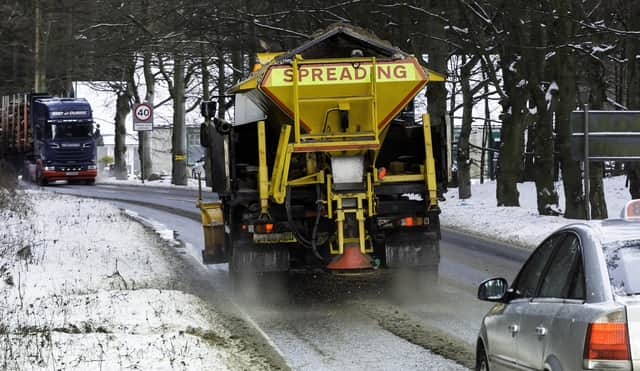Aberdeenshire Council budget: “Everything is on the table” to plug the gap


The local authority will be forced to make some difficult choices in the next few weeks as it looks to balance its books.
In an exclusive interview with council chiefs, we asked what could be at risk ahead of the financial setting exercise.
Advertisement
Hide AdAdvertisement
Hide AdCouncil leader Gillian Owen warned that “everything is on the table” – but what does that mean for the region’s road network and winter maintenance plans?
During the recent wintry spell the local authority used around 4,000 tonnes of salt on 2,500 miles of road per day as temperatures plummeted.
Across the region, 120 farmers were contracted to help shift the snow with staff working a combined 1,000 hours each day.
Aberdeenshire Council employs around 300 dedicated roads and landscape staff to operate its fleet of 55 gritters and support vehicles.
During harsh conditions, local authority workers hit the roads to ensure priority routes are passible at all times – unless weather conditions are particularly severe.
These 32 routes are mostly ‘A’ and ‘B’ class roads covering a whopping 1,081 miles.
But the price of keeping Aberdeenshire moving in the winter is steadily increasing.
Aberdeenshire Council uses an estimated 45,000 tonnes of salt every winter on its roads and pavements.
Advertisement
Hide AdAdvertisement
Hide AdBut the price per tonne of salt has increased by around 15% over the last five years.
Tumbling temperatures and spells of snow last year resulted in the council going £1.2 million over budget on its winter maintenance costs.
But could the council cut back on the amount of salt it buys?
Infrastructure services chairman Alan Turner said this could be something it considers but added: “It’s such a variable, you don’t know how bad the winter is going to be. Going back the last couple of years the worst of the weather in terms of snow and ice is typically what we are about to go into, January to March, so it’s still a big unknown.”
The council has prioritised the routes it grits and later ploughs in the event of moderate or heavy snowfall.
Mr Turner said the council always carefully considers the decision of whether to grit a road or not and the risks they face any are left untreated.
He explained that Aberdeenshire Council typically grits a route twice, but there are occasions where just one treatment is enough.
However the cost of a full treatment, where a route is gritted two times, is getting more expensive, increasing by a staggering 43% in the last ten years.
Advertisement
Hide AdAdvertisement
Hide AdMr Turner said the costs associated with staff, equipment, and materials was to blame.
“Some of that is inflationary-type pressures, some of it is just that it physically costs more than what it did ten years ago.”
We also asked if the council would consider changing the routes it currently covers.
Council leader Gillian Owen suggested this would be something that is looked at going forward but the local authority is keen to avoid any “unintended consequences”.
Aberdeenshire Council has 3,476 miles of roads to treat during the winter and repair throughout the year. To replace a one mile stretch of road carriageway would cost around £33,200.
Alongside this, they manage and maintain 900 miles of pavements and 113 car parks.
All of this work is overseen by around 420 members of frontline roads crew.
But is the council prepared to make any changes to its staff numbers?
Advertisement
Hide AdAdvertisement
Hide AdMr Turner noted there is a “relatively high” vacancy rate in the roads department and that some of these unfilled posts could be cut in a bid to balance the books.
However, the existing workforce will be safe as deputy leader Anne Stirling confirmed the local authority will not be looking at compulsory redundancies.
Ms Owen added: “If we had the full compliment it might be a different matter but we haven’t got that. It would be harsh if we had to go down that route.”
The council receives help from farmers and contractors across the region to help shift snow from the roads.
However due to the increase in fuel prices, the rate charged per hour for this winter season has increased by 28% for farmers and 26% for contractors.
But as the council doesn’t have the staff to cover all of the region’s roads, it relies on the “valuable” extra help and isn’t planning to cut this down either.
Ms Owen said there is a belief amongst residents that the local authority should clear every road and pavement in Aberdeenshire.
But realistically, this is something that is not possible.
“Currently the expectation is that the council should do everything and we just cannot do that,” she stated. “We have to prioritise in that respect and there are winners and losers.”
Advertisement
Hide AdAdvertisement
Hide AdMeanwhile deputy leader Anne Stirling suggested that residents should partner with the council and lend a hand in their own communities.
She is encouraging people to sign-up to its volunteer snow warden scheme.
Residents can also do their bit by applying for a public grit bin or requesting a salt top-up through the myAberdeenshire site.
Meanwhile, the local authority is responsible for the upkeep of 1,311 bridges – this equates to one every 2.7 miles.
Inspections of the region’s bridges are carried out every year to assess their condition and to identify if any maintenance or replacement work is needed.
What services matter the most to you and where do you think savings could be made?
To share your thoughts, access the budget engagement survey by visiting engage.aberdeenshire.gov.uk/aberdeenshirecouncilbudget-2024-25.